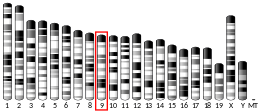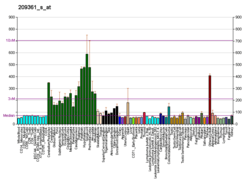PCBP4
Poly(rC)-binding protein 4 is a protein that in humans is encoded by the PCBP4 gene.[5][6]
| PCBP4 | |||||||||||||||||||||||||
|---|---|---|---|---|---|---|---|---|---|---|---|---|---|---|---|---|---|---|---|---|---|---|---|---|---|
| Identifiers | |||||||||||||||||||||||||
| Aliases | PCBP4, CBP, LIP4, MCG10, poly(rC) binding protein 4 | ||||||||||||||||||||||||
| External IDs | OMIM: 608503 MGI: 1890471 HomoloGene: 56926 GeneCards: PCBP4 | ||||||||||||||||||||||||
| |||||||||||||||||||||||||
| |||||||||||||||||||||||||
| |||||||||||||||||||||||||
| |||||||||||||||||||||||||
| Orthologs | |||||||||||||||||||||||||
| Species | Human | Mouse | |||||||||||||||||||||||
| Entrez | |||||||||||||||||||||||||
| Ensembl | |||||||||||||||||||||||||
| UniProt | |||||||||||||||||||||||||
| RefSeq (mRNA) | |||||||||||||||||||||||||
| RefSeq (protein) | |||||||||||||||||||||||||
| Location (UCSC) | Chr 3: 51.96 – 51.97 Mb | Chr 9: 106.45 – 106.46 Mb | |||||||||||||||||||||||
| PubMed search | [3] | [4] | |||||||||||||||||||||||
| Wikidata | |||||||||||||||||||||||||
| |||||||||||||||||||||||||
This gene encodes a member of the KH domain protein subfamily. Proteins of this subfamily, also referred to as alpha-CPs, bind to RNA with a specificity for C-rich pyrimidine regions. Alpha-CPs play important roles in post-transcriptional activities and have different cellular distributions. This gene is induced by the p53 tumor suppressor, and the encoded protein can suppress cell proliferation by inducing apoptosis and cell cycle arrest in G(2)-M. This gene's protein is found in the cytoplasm, yet it lacks the nuclear localization signals found in other subfamily members. Multiple alternatively spliced transcript variants have been described, but the full-length nature for only some has been determined.[6]
References
- GRCh38: Ensembl release 89: ENSG00000090097 - Ensembl, May 2017
- GRCm38: Ensembl release 89: ENSMUSG00000023495 - Ensembl, May 2017
- "Human PubMed Reference:". National Center for Biotechnology Information, U.S. National Library of Medicine.
- "Mouse PubMed Reference:". National Center for Biotechnology Information, U.S. National Library of Medicine.
- Makeyev AV, Liebhaber SA (Sep 2000). "Identification of two novel mammalian genes establishes a subfamily of KH-domain RNA-binding proteins". Genomics. 67 (3): 301–16. doi:10.1006/geno.2000.6244. PMID 10936052.
- "Entrez Gene: PCBP4 poly(rC) binding protein 4".
Further reading
- Taylor WR, Stark GR (2001). "Regulation of the G2/M transition by p53". Oncogene. 20 (15): 1803–15. doi:10.1038/sj.onc.1204252. PMID 11313928.
- Makeyev AV, Liebhaber SA (2002). "The poly(C)-binding proteins: a multiplicity of functions and a search for mechanisms". RNA. 8 (3): 265–78. doi:10.1017/S1355838202024627. PMC 1370249. PMID 12003487.
- Kiledjian M, Wang X, Liebhaber SA (1995). "Identification of two KH domain proteins in the alpha-globin mRNP stability complex". EMBO J. 14 (17): 4357–64. doi:10.1002/j.1460-2075.1995.tb00110.x. PMC 394520. PMID 7556077.
- Maruyama K, Sugano S (1994). "Oligo-capping: a simple method to replace the cap structure of eukaryotic mRNAs with oligoribonucleotides". Gene. 138 (1–2): 171–4. doi:10.1016/0378-1119(94)90802-8. PMID 8125298.
- Suzuki Y, Yoshitomo-Nakagawa K, Maruyama K, et al. (1997). "Construction and characterization of a full length-enriched and a 5'-end-enriched cDNA library". Gene. 200 (1–2): 149–56. doi:10.1016/S0378-1119(97)00411-3. PMID 9373149.
- Zhu J, Chen X (2000). "MCG10, a novel p53 target gene that encodes a KH domain RNA-binding protein, is capable of inducing apoptosis and cell cycle arrest in G(2)-M". Mol. Cell. Biol. 20 (15): 5602–18. doi:10.1128/MCB.20.15.5602-5618.2000. PMC 86022. PMID 10891498.
- Tchernev VT, Mansfield TA, Giot L, et al. (2002). "The Chediak-Higashi protein interacts with SNARE complex and signal transduction proteins". Mol. Med. 8 (1): 56–64. doi:10.1007/bf03402003. PMC 2039936. PMID 11984006.
- Strausberg RL, Feingold EA, Grouse LH, et al. (2003). "Generation and initial analysis of more than 15,000 full-length human and mouse cDNA sequences". Proc. Natl. Acad. Sci. U.S.A. 99 (26): 16899–903. doi:10.1073/pnas.242603899. PMC 139241. PMID 12477932.
- Chkheidze AN, Liebhaber SA (2003). "A novel set of nuclear localization signals determine distributions of the alphaCP RNA-binding proteins". Mol. Cell. Biol. 23 (23): 8405–15. doi:10.1128/MCB.23.23.8405-8415.2003. PMC 262676. PMID 14612387.
- Ota T, Suzuki Y, Nishikawa T, et al. (2004). "Complete sequencing and characterization of 21,243 full-length human cDNAs". Nat. Genet. 36 (1): 40–5. doi:10.1038/ng1285. PMID 14702039.
- Gerhard DS, Wagner L, Feingold EA, et al. (2004). "The status, quality, and expansion of the NIH full-length cDNA project: the Mammalian Gene Collection (MGC)". Genome Res. 14 (10B): 2121–7. doi:10.1101/gr.2596504. PMC 528928. PMID 15489334.
- Lim J, Hao T, Shaw C, et al. (2006). "A protein-protein interaction network for human inherited ataxias and disorders of Purkinje cell degeneration". Cell. 125 (4): 801–14. doi:10.1016/j.cell.2006.03.032. PMID 16713569.




